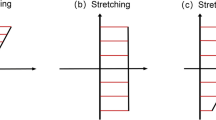Abstract
To improve the aerodynamic performance of high-end equipment, the mirror-symmetrically 3D curved aluminum structural parts are increasingly assembled in the manufacturing industry. A new type of multi-points 3D stretch-press-bending (3D SPB) process for forming this kind of component is proposed in this paper. A prototype of this process is developed. The 3D SPB experiments are carried out. This new process realizes the complex bending for multi-directional curvature radius, which increases the material utilization by 6.79% and doubles the production efficiency. Then, the numerical simulation models are established. It has a good prediction result for the 3D springback. The maximum relative error of springback prediction is less than 20%. Besides, the effect of pre-stretching and post-stretching are investigated, which determines the most suitable forming parameters at \(\varepsilon_{{\text{s}}}\) pre-stretching and 0.3 \(\varepsilon_{{\text{s}}}\) post-stretching. At last, the springback direct compensation method is applied to the precise forming of the target part. Though two times adjustment, the deviation reduces effectively. The precise forming experiment is carried out based on the optimized forming parameters. The maximum total deviation is 1.52 mm, which satisfies the forming requirement. The 3D SPB process achieves the pairwise forming of the W-shaped mirror-symmetric structural parts and improves production efficiency.



















Similar content being viewed by others
References
Vollertsen, F., Sprenger, A., Kraus, J., & Arnet, H. (1999). Extrusion, channel, and profile bending: A review. Journal of Materials Processing Technology, 87(1–3), 1–27. https://doi.org/10.1016/S0924-0136(98)00339-2
Xunzhong, G., Hao, X., Heng, L., Yong, X., Ziqi, M., Abd, E. A. A., et al. (2018). Forming characteristics of tube free-bending with small bending radii based on a new spherical connection. International Journal of Machine Tools and Manufacture, 133, 72–84.
Miller, J. E., Kyriakides, S., & Bastard, A. H. (2001). On bend-stretch forming of aluminum extruded tubes—I: Experiments. International Journal of Mechanical Sciences, 43(5), 1283–1317. https://doi.org/10.1016/s0020-7403(00)00039-4
Liu, T. J., Wang, Y. J., Wu, J. J., Xia, X. J., Wang, J. B., Wang, W., & Wang, S. H. (2015). Springback analysis of Z & T-section 2196–T8511 and 2099–T83 Al-Li alloys extrusions in displacement controlled cold stretch bending. Journal of Materials Processing Technology, 225, 295–309. https://doi.org/10.1016/j.jmatprotec.2015.05.024
Chatti, S., Hermes, M., Tekkaya, A. E., & Kleiner, M. (2010). The new TSS bending process: 3D bending of profiles with arbitrary cross-sections. CIRP Annals—Manufacturing Technology, 59(1), 315–318. https://doi.org/10.1016/j.cirp.2010.03.017
Liang, J.-c, Gao, S., Teng, F., Yu, P.-z, & Song, X.-j. (2014). Flexible 3D stretch-bending technology for aluminum profile. International Journal of Advanced Manufacturing Technology, 71(9–12), 1939–1947. https://doi.org/10.1007/s00170-013-5590-9
Gao, S., Liang, J. C., Li, Y., Hao, Z. P., Li, Q. H., Fan, Y. H., & Sun, Y. L. (2018). Precision forming of the 3D curved structure parts in flexible multi-points 3D stretch-bending process. The International Journal of Advanced Manufacturing Technology, 95(1–4), 1205–1213. https://doi.org/10.1007/s00170-017-1276-z
Corona, E. (2004). Simple analysis for bend-stretch forming of aluminum extrusions. International Journal of Mechanical Sciences, 46(3), 433–448. https://doi.org/10.1016/j.ijmecsci.2004.03.010
Clausen, A. H., Hopperstad, O. S., & Langseth, M. (2001). Sensitivity of model parameters in stretch bending of aluminium extrusions. International Journal of Mechanical Sciences, 43(2), 427–453. https://doi.org/10.1016/s0020-7403(00)00012-6
Wagoner, R. H., Lim, H., & Lee, M.-G. (2013). Advanced Issues in springback. International Journal of Plasticity, 45, 3–20. https://doi.org/10.1016/j.ijplas.2012.08.006
Elsharkawy, A. A., & El-Domiaty, A. A. (2001). Determination of stretch-bendability limits and springback for T-section beams. Journal of Materials Processing Technology, 110(3), 265–276. https://doi.org/10.1016/S0924-0136(00)00885-2
Teng, F., Zhang, W., Liang, J., & Gao, S. (2015). Springback prediction and optimization of variable stretch force trajectory in three-dimensional stretch bending process. Chinese Journal of Mechanical Engineering, 28(6), 1132–1140.
Yu, C. L., & Li, X. Q. (2011). Theoretical analysis on springback of L-section extrusion in rotary stretch bending process. Transactions of the Nonferrous Metals Society of China, 21(12), 2705–2710. https://doi.org/10.1016/s1003-6326(11)61113-8
Zhu, H., & Stelson, K. A. (2003). Modeling and closed-loop control of stretch bending of aluminum rectangular tubes. Journal of Manufacturing Science & Engineering, 125(1), 113.
Eggertsen, P. A., & Mattiasson, K. (2010). On constitutive modeling for springback analysis. International Journal of Mechanical Sciences, 52(6), 804–818.
Dassault Systemes Simulia Corp (2014). Abaqus Analysis User’s Manual 6.14; Dassault systemes simulia corp: Providence, RI, USA.
Paulsen, F., & Welo, T. (2001). Cross-sectional deformations of rectangular hollow sections in bending: Part I—experiments. International Journal of Mechanical Sciences, 43(1), 109–129. https://doi.org/10.1016/S0020-7403(99)00106-X
Li, G., Liu, Y., Du, T., & Tong, H. (2014). Algorithm research and system development on geometrical springback compensation system for advanced high-strength steel parts. The International Journal of Advanced Manufacturing Technology, 70(1–4), 413–427.
Acknowledgements
This work was supported by the National Natural Science Foundation of China (No.51805045) and Scientific and Technological Developing Scheme of Ji Lin Province (No. 20200401115GX)
Author information
Authors and Affiliations
Corresponding author
Ethics declarations
Conflict of interest
The authors declare that they have no known competing financial interests or personal relationships that could have appeared to influence the work reported in this paper.
Additional information
Publisher's Note
Springer Nature remains neutral with regard to jurisdictional claims in published maps and institutional affiliations.
Rights and permissions
About this article
Cite this article
Gao, S., Sun, Y., Li, Q. et al. Multi-points 3D Stretch-Press-Bending Process for Forming of W-Shaped Mirror-Symmetrical Structural Parts. Int. J. Precis. Eng. Manuf. 23, 255–267 (2022). https://doi.org/10.1007/s12541-021-00604-z
Received:
Revised:
Accepted:
Published:
Issue Date:
DOI: https://doi.org/10.1007/s12541-021-00604-z



